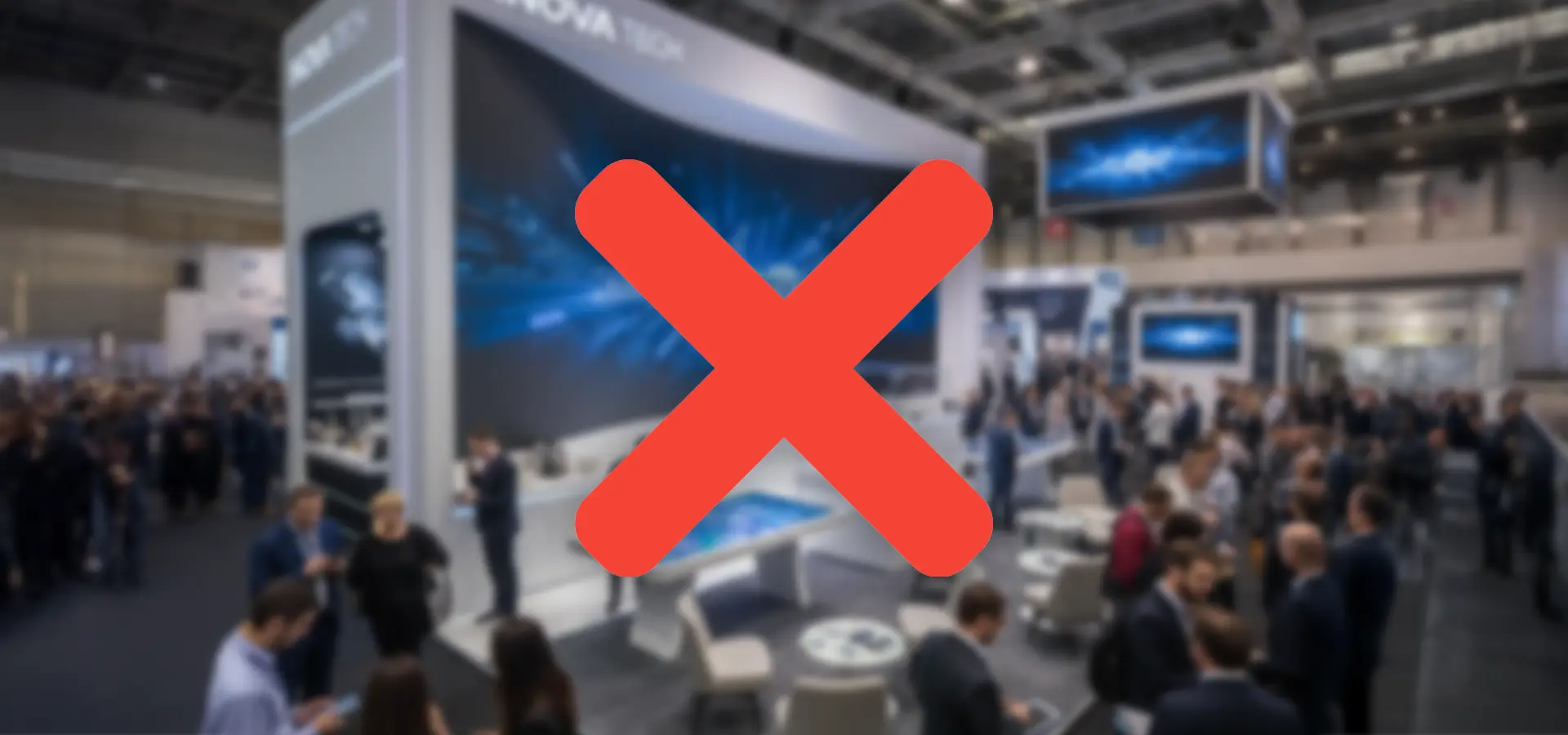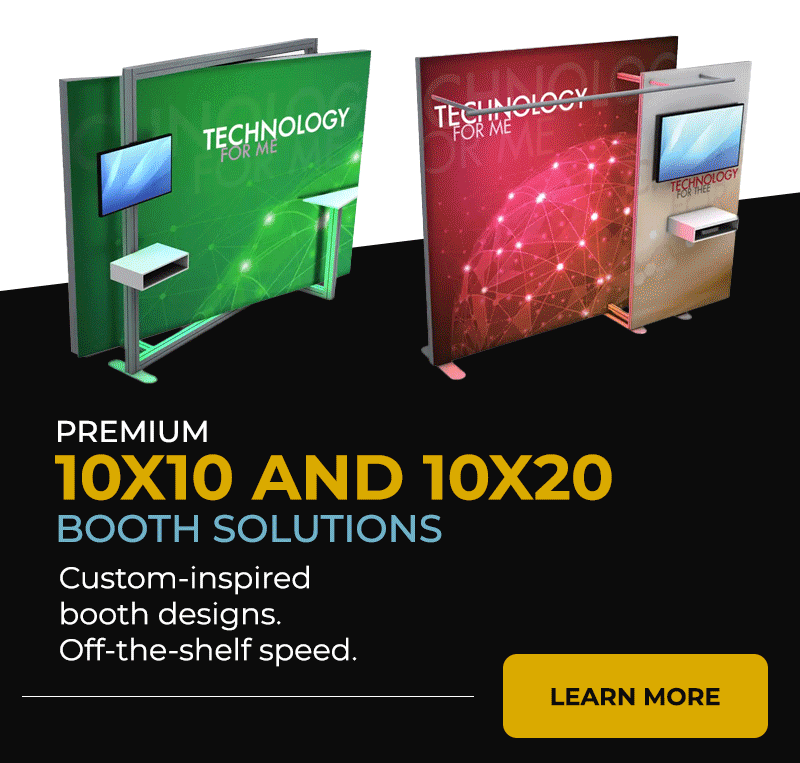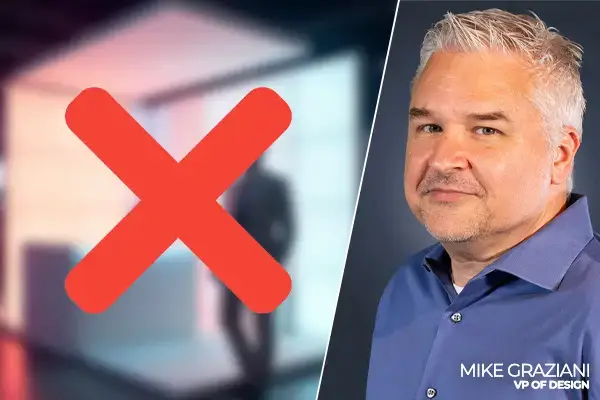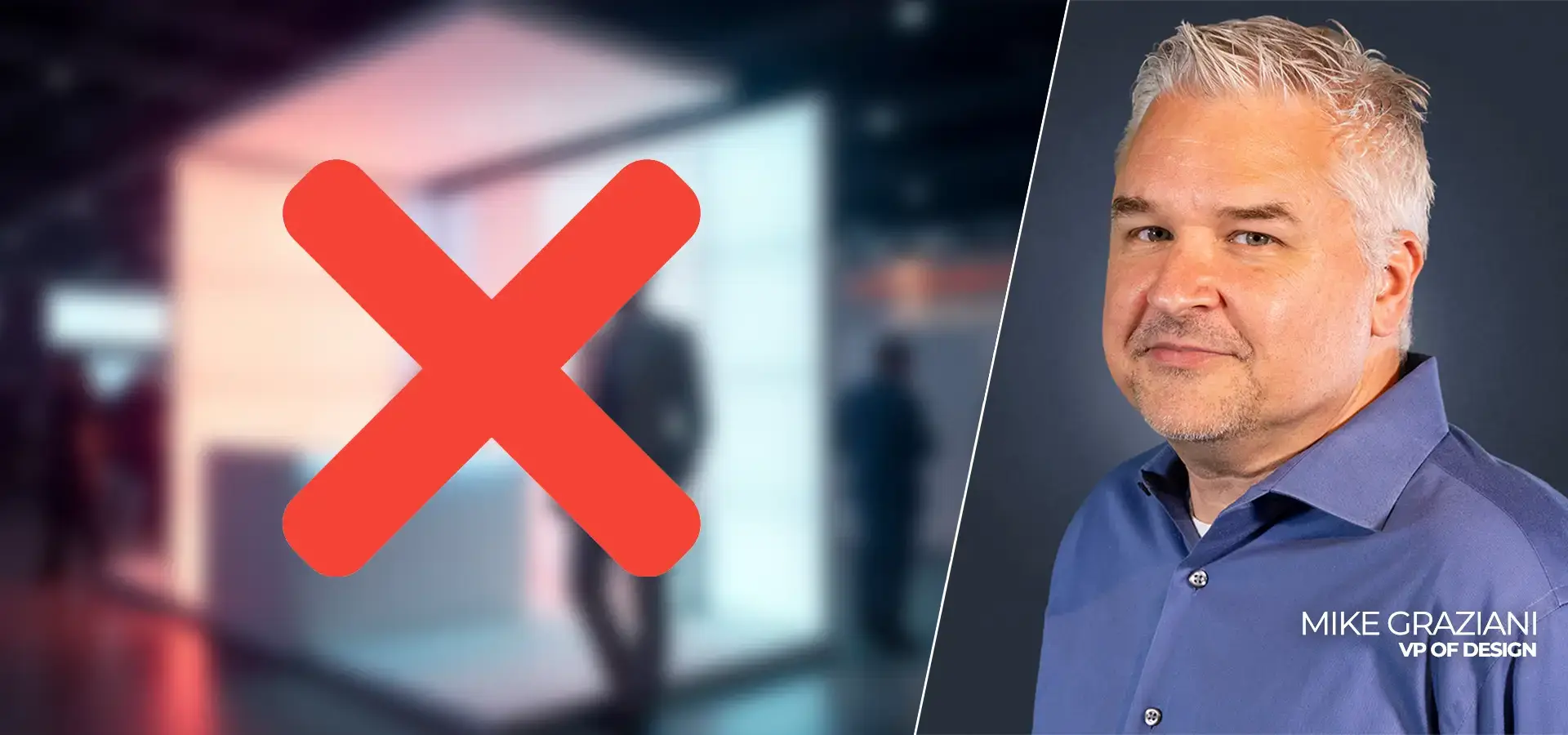In the words of Henry Ford: “The only real mistake is the one from which we learn nothing.”
With that in mind, we’ve narrowed down the most common mistakes exhibitors make before, during, and after a show.
We’ve also offered you tips on how to avoid them so that you don’t even make them in the first place.
Before the show
Exhibitors quite often shoot themselves in the foot before they’ve even entered the exhibition space.
Here are the most common mistakes we see them make when preparing for their next show.
Not building hype
No hype equals no hope of meeting all your warm leads.
Yes, you may have strong relationships with certain exhibitors from previous shows.
But these relationships could fizzle out pretty quickly if you let yourself drop off the radar. Out of sight, out of mind, as the saying goes.
Building hype online will keep you firmly front of mind, and it’s pretty easy to do.
First off, you need to create a content strategy outlining:
- Your ideal target audience (job titles, purchasing triggers, whether they’re the chief decision maker).
- The pain points your product or service solves.
- Your key messaging.
- What types of content you’re going to create (e.g., a bespoke landing page, email sequences, social media posts, paid ads, webinars, LinkedIn Live Q&A).
- Which channels you’re going to use to target your audience.
- How often you’re going to share content on these channels.
Then it’s a case of executing this strategy and being consistent.
Putting out two or three well-curated social media posts per week around one to three months before the show is optimal.
If you do this, you’re already several steps ahead of many other trade show exhibitors.
Oh, and by the way—don’t ‘post and ghost.’ Keep on top of the social media comments you receive, and if someone attending the show comments on your LinkedIn post, make sure you respond to them!
Not reaching out to warm leads
Of course, you can’t just post content before the event and wait for attendees to engage. You need to reach out to leads directly as well.
A simple phone call, LinkedIn direct message, or personalized email won’t do any harm.
Attendees, as we know, are often working to a tight itinerary and will be visiting A LOT of stands in a relatively short space of time.
If they don’t have your stand penciled in their diary, something’s wrong.
You risk them just passing by in a hurry on their way to meet the exhibitors who made the effort to reach out to them.
Waiting until the 11th hour to get your booth designed
We sometimes receive requests from exhibitors to start designing their booth around one to two months before the show.
While this is doable, it’s a tight squeeze and far from an optimal timeframe if we’re required to create something complex.
To get the best possible results every time and avoid last-minute complications, exhibitors should give their trade show partner six months’ advance notice.
Working to this timeframe means you’ll be in a great position three months out from your event. Your trade show partner will know exactly what they're trying to execute, they’ll have a design, and they’ll have a clear plan.
Then it's just a matter of executing that plan.
Not training staff in advance
Exhibitors can spend months preparing a nice-looking booth but overlook preparing their team.
The last thing you want is for your hard work to be undermined by underprepared booth staff.
Companies can sometimes send junior members of staff to a show or fail to brief them on the questions they may be asked or a key selling point of their product or service that they need to communicate.
Even if they know your product or service like the back of their hand, that doesn’t mean they’ll know how to respond to specific questions in a busy trade show environment.
Whoever is going to your next show, they need to know what they’re going to say and how they’re going to keep attendees in your booth.
During the show
Now let’s look at the biggest mistakes we see exhibitors make on the trade show floor.
Not being engaged inside the booth
Hopefully, your booth staff aren’t giving off disengaged vibes!
That said, we have encountered instances where exhibitors have been sitting down, scrolling on their phones, eating in their booth in the middle of the show, and chatting among themselves.
This doesn’t communicate that they want to help people. It doesn’t communicate that they’re passionate about what they do.
Attendees can pick up on this energy instantly—if they feel like their presence in your booth doesn’t matter, they’ll be gone in seconds.
This should be the most self-explanatory tip in our article, but make sure you look prepared and receptive.
Having a busy booth layout
A trade show can be a million miles an hour, so the last thing any attendee wants is:
- Bottlenecks.
- A booth with poor traffic flow.
- Cluttered displays and unclear pathways that discourage entry.
Again, we’ve seen many booths that are just like this.
They look cramped, and they’re not conducive to retaining foot traffic or initiating meaningful conversations.
You can avoid this fate by working with a strategic trade show partner who can advise you on how to create a booth layout that represents clarity rather than chaos.
Not capturing leads properly
Even today, it’s not uncommon for exhibitors to collect business cards and refer to hastily written notes and call this lead capture.
There’s so much cutting-edge technology at your disposal today that you’d be remiss not to take advantage of it.
It’s never been easier for you to instantly capture attendee details, gain actionable insights into their needs, and curate a list of high-quality, qualified leads—so make the most of this unique opportunity!
No interactive elements, demos, or meaningful giveaways
We often use the word ‘immersive’ when writing or talking about trade shows. It’s not just a buzzword—it speaks to how actively engaged and engrossed an attendee must feel in your brand.
A bit of small talk between you and the attendee isn’t going to cut it.
That attendee needs to see, feel, and experience your product or service for themselves, and you can help them do this in several ways.
Firstly, through interactive elements.
We’ve created a lot of content about why exhibitors need to incorporate digital and interactive features and go a step further than competing exhibitors—and with good reason.
https://www.youtube.com/watch?v=KXBchtvoutM
Studies indicate that exhibitions using interactive technology see an average 300% increase in visitor engagement rates and 45% longer dwell times.
If these stats alone aren’t testament to the role of interactive elements in your booth, we’re not sure what is.
Then there’s demos. You don’t need us to preach the importance of demos to you, especially if you’re a seasoned exhibitor. Everybody appreciates the chance to try before they buy. If you can make these demos private and bespoke to the individual, even better.
Finally, make your giveaways count for something. Don’t invest time and money sourcing gifts that people will just throw away.
https://www.youtube.com/watch?v=oA6sf2HJaMY
Instead, offer something more personalized and strategic. For example, items that attendees can create themselves, such as customized, branded apparel and engraved, reusable water bottles.
After the show
This is the point at which some exhibitors make the fatal mistake of resting on their laurels.
They showed up with a great booth and walked away with a solid list of leads.
Now it’s just a case of waiting for people to call and closing deals, right?
Wrong.
This is where the hard work starts.
Here’s what you shouldn’t do once you return to work from the show.
Not following up after the show
According to research, an incredible 81% of trade show leads are never followed up on. We had to do a double take when we read this stat.
Imagine how many clients—and how much money—exhibitors are letting slip from their grasp by not having an efficient follow-up sales process in place.
This matters more than you may think. Field sales teams who master post-event follow-up see 60% higher conversion rates than those who delay their outreach.
Here are some of the ways your staff can follow up with warm leads:
- Send personalized thank-you emails within 24 to 48 hours of the show’s conclusion. Don’t send generic emails packed with fluffy messaging that could have been sent to anyone.
- Drop them a short private message on LinkedIn, referencing a detail particular to them that you noted down or found of interest. Or, ask them an open-ended question such as, ‘What would need to happen for us to work together?’ or ‘What factors are most important in your decision-making process going forward?’
- Like and comment on social media posts from attendees to further nurture the relationship. This keeps you front of mind and lets them know you’re thinking about them.
Not segmenting leads
This is one of the biggest cardinal sins we see exhibitors commit.
Treating every interaction as equal is the sign of a lazy sales process and detracts attention from those most likely to close.
No two interactions are equal, nor are two trade show attendees. Every pain point and personal preference must be treated on its own merit and approached accordingly.
Here’s a simple A to C scoring system that can help you segment your leads effectively:
- An A lead fits your Ideal Customer Profile (ICP). They have a clear need for your product or service, have expressed a strong interest in it, and have the authority to make budgetary decisions.
- A B lead is someone who is moderately engaged and qualified, but there’s no definitive timeline as to when or if they’ll buy from you. They’re researching their options and plan on initiating a purchase in the next 3-6 months, but they may not have the authority to sign off on a potential deal.
- A C lead is someone who’s shown interest in your product or service but is otherwise a poor profile fit. You wouldn’t prioritize following up with this person.
Having this scoring system ready before you even walk onto the trade show floor will make the post-show follow-up much more focused and efficient.
Related: 9 Marketing and Sales Tactics For Trade Show Exhibitors
Not nurturing long-term leads
As we wrote above, some leads will be A leads and ready to buy right now. Some leads will be B leads who need a bit of nurturing, and that’s ok.
Don’t overlook them like many exhibitors do.
Exhibitors often make the mistake of treating trade show leads as ‘one-and-done’ instead of viewing them as part of an ongoing nurture cycle.
Just because certain leads aren't ready to buy today, this doesn’t mean they won’t be in a position to buy this time next year, or even sooner.
Following up strategically and continuing to build a relationship with this person puts you in the strongest possible position if the day comes when they’re ready to invest in your product or service.
Failing to debrief the team
We’ll let you in on a secret—no exhibitor gets everything right all of the time.
Even if you stood head and shoulders above your competitors, attracted your ideal customers, and had some very productive conversations, there’s always room for improvement.
Whether it’s the questions you asked, a small detail of your booth layout, or something you could have explained better during the demo, something will stand out in your mind as not quite hitting the mark when the dust settles.
But without reviewing what worked and didn’t work, you’re bound to repeat the same mistakes and miss out on golden opportunities further down the road.
Your biggest mistake could be not reaching out to us today
As we alluded to throughout this article, we’ve seen exhibitors make their fair share of mistakes over the years, having been in business since 1986.
These mistakes are not only expensive but could also be detrimental to a business’s reputation and cause it to lose vital ground on its competitors.
Good thing you’re not one of these exhibitors, then.
Prevent avoidable mistakes, and make your business stand out with an immersive storytelling asset by reaching out to us today.
Send us a note here or call us at 800-343-2005.








